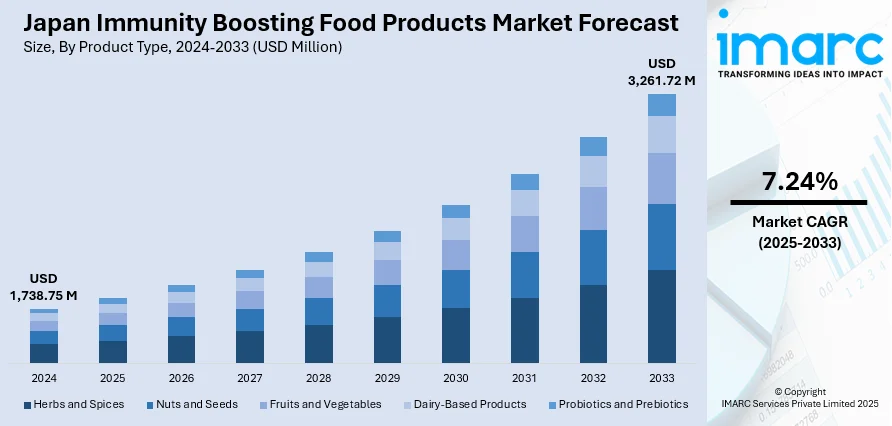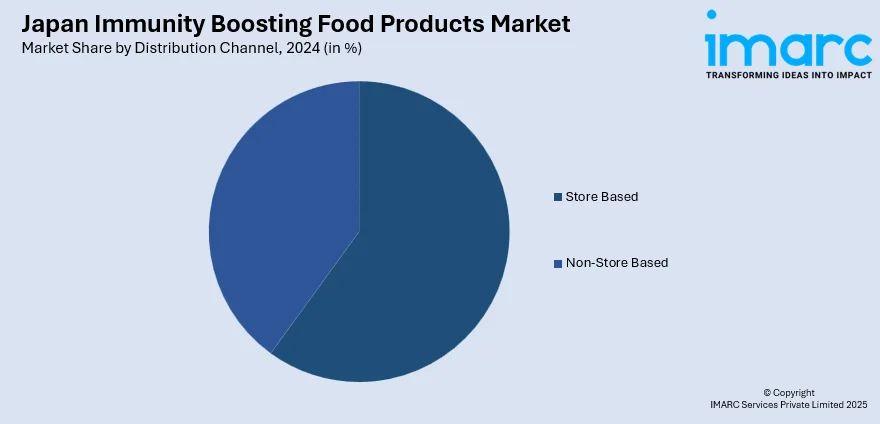
Japan Immunity Boosting Food Products Market Size, Share, Trends and Forecast by Product Type, Distribution Channel, and Region, 2025-2033
Japan Immunity Boosting Food Products Market Overview:
The Japan immunity boosting food products market size reached USD 1,738.75 Million in 2024. Looking forward, IMARC Group expects the market to reach USD 3,261.72 Million by 2033, exhibiting a growth rate (CAGR) of 7.24% during 2025-2033. At present, the growing adoption of health-conscious lifestyles is encouraging people to utilize immunity boosting food products that support overall well-being. Besides this, the broadening of retail outlets, which aid in enhancing accessibility of items, is contributing to the expansion of the Japan immunity boosting food products market share.
|
Report Attribute
|
Key Statistics
|
|---|---|
|
Base Year
|
2024
|
|
Forecast Years
|
2025-2033
|
|
Historical Years
|
2019-2024
|
| Market Size in 2024 | USD 1,738.75 Million |
| Market Forecast in 2033 | USD 3,261.72 Million |
| Market Growth Rate 2025-2033 | 7.24% |
Japan Immunity Boosting Food Products Market Trends:
Rise in health-conscious lifestyles
Rising shift towards health-conscious lifestyles is positively influencing the market in Japan. People are prioritizing nutrition and preventive care, which is leading them to include ingredients like probiotics, vitamins, herbs, and superfoods in their daily diets. This transition reflects a broader cultural trend of balanced eating and mindful consumption. People are focusing on strengthening their immune systems through natural means rather than relying solely on medications. Consequently, the demand is growing for items, such as fortified beverages, fermented food products, and dietary supplements that promote immunity. Health-conscious individuals read product labels, avoid artificial additives, and choose clean-label and organic options. This change in dietary habits is motivating food manufacturers to innovate and develop items with immune-supporting claims. The trend also aligns with Japan’s aging population, which prefers food products that contribute to longevity and vitality. Based on data released by Japan’s Ministry of Internal Affairs and Communications, as of September 2024, older adults constituted approximately 29.3% of the population, a larger share than in any other country or area with over 100,000 residents. Educational campaigns and media are further spreading awareness about the benefits of healthy eating, thereby supporting the growth of the market.

To get more information of this market, Request Sample
Expansion of retail channels
The broadening of retail channels is impelling the Japan immunity boosting food products market growth. As per industry reports, in April 2025, retail sales in Japan rose by 0.50% compared to March 2025. As retail networks are expanding across the country, people are gaining easier access to a wide range of health-oriented food options. Supermarkets, convenience stores, and health food outlets stock more products that support immune health, such as fortified juices, herbal teas, functional snacks, and dietary supplements. This growth is not only increasing visibility but also encouraging impulse buying and regular consumption. Organized retail chains often run promotions and highlight health benefits on packaging, which helps educate shoppers and influence their choices. Urban areas in Japan are witnessing the rise of specialty health stores, while rural areas are also benefiting from better supply through expanding retail distribution. With more shelf space dedicated to wellness and nutrition, immunity boosting food products have become more mainstream. Retailers are collaborating with manufacturers to launch private label products and exclusive items. The convenience and availability offered by expanding retail channels make it easier for health-conscious consumers to integrate these products into their daily lives. As retail continues to grow and modernize, it is significantly supporting the rising demand for immunity-focused nutrition.
Japan Immunity Boosting Food Products Market Segmentation:
IMARC Group provides an analysis of the key trends in each segment of the market, along with forecasts at the country and regional levels for 2025-2033. Our report has categorized the market based on product type and distribution channel.
Product Type Insights:
- Herbs and Spices
- Nuts and Seeds
- Fruits and Vegetables
- Dairy-Based Products
- Probiotics and Prebiotics
The report has provided a detailed breakup and analysis of the market based on the product type. This includes herbs and spices, nuts and seeds, fruits and vegetables, dairy-based products, and probiotics and prebiotics.
Distribution Channel Insights:

- Store Based
- Non-Store Based
A detailed breakup and analysis of the market based on the distribution channel have also been provided in the report. This includes store based and non-store based.
Regional Insights:
- Kanto Region
- Kansai/Kinki Region
- Central/ Chubu Region
- Kyushu-Okinawa Region
- Tohoku Region
- Chugoku Region
- Hokkaido Region
- Shikoku Region
The report has also provided a comprehensive analysis of all the major regional markets, which include Kanto Region, Kansai/Kinki Region, Central/Chubu Region, Kyushu-Okinawa Region, Tohoku Region, Chugoku Region, Hokkaido Region, and Shikoku Region.
Competitive Landscape:
The market research report has also provided a comprehensive analysis of the competitive landscape. Competitive analysis such as market structure, key player positioning, top winning strategies, competitive dashboard, and company evaluation quadrant has been covered in the report. Also, detailed profiles of all major companies have been provided.
Japan Immunity Boosting Food Products Market News:
- In May 2025, Probi collaborated with Nomura Dairy Products Co., Ltd, a manufacturer focused on gut health and a pioneer in functional beverage innovation, to introduce Japan’s first fermented probiotic drink enriched with Probi’s Lactiplantibacillus plantarum 299v (LP299V) under the brand ‘My Flora.’ Created for health-focused individuals looking for digestive assistance, this product merged the inherent nutritional advantages of carrot juice with the scientifically validated benefits of LP299V, delivering thorough support for gut health.
- In February 2025, the Japanese government revealed the implementation of new food safety documentation regulations for manufacturers of milk products, along with functional foods, beverages, and infant formula that included probiotics. Companies were required to provide documents detailing the name and location of the manufacturing site, the product name, the ingredients utilized, and the mixing proportions. Probiotic bacteria in all food items had to exhibit antibiotic resistance that was similar to or lower than that of other strains of the same species.
Japan Immunity Boosting Food Products Market Report Coverage:
| Report Features | Details |
|---|---|
| Base Year of the Analysis | 2024 |
| Historical Period | 2019-2024 |
| Forecast Period | 2025-2033 |
| Units | Million USD |
| Scope of the Report |
Exploration of Historical Trends and Market Outlook, Industry Catalysts and Challenges, Segment-Wise Historical and Future Market Assessment:
|
| Product Types Covered | Herbs and Spices, Nuts and Seeds, Fruits and Vegetables, Dairy-Based Products, Probiotics and Prebiotics |
| Distribution Channels Covered | Store-Based, Non-Store Based |
| Regions Covered | Kanto Region, Kansai/Kinki Region, Central/Chubu Region, Kyushu-Okinawa Region, Tohoku Region, Chugoku Region, Hokkaido Region, Shikoku Region |
| Customization Scope | 10% Free Customization |
| Post-Sale Analyst Support | 10-12 Weeks |
| Delivery Format | PDF and Excel through Email (We can also provide the editable version of the report in PPT/Word format on special request) |
Key Questions Answered in This Report:
- How has the Japan immunity boosting food products market performed so far and how will it perform in the coming years?
- What is the breakup of the Japan immunity boosting food products market on the basis of product type?
- What is the breakup of the Japan immunity boosting food products market on the basis of distribution channel?
- What is the breakup of the Japan immunity boosting food products market on the basis of region?
- What are the various stages in the value chain of the Japan immunity boosting food products market?
- What are the key driving factors and challenges in the Japan immunity boosting food products market?
- What is the structure of the Japan immunity boosting food products market and who are the key players?
- What is the degree of competition in the Japan immunity boosting food products market?
Key Benefits for Stakeholders:
- IMARC’s industry report offers a comprehensive quantitative analysis of various market segments, historical and current market trends, market forecasts, and dynamics of the Japan immunity boosting food products market from 2019-2033.
- The research report provides the latest information on the market drivers, challenges, and opportunities in the Japan immunity boosting food products market.
- Porter's five forces analysis assist stakeholders in assessing the impact of new entrants, competitive rivalry, supplier power, buyer power, and the threat of substitution. It helps stakeholders to analyze the level of competition within the Japan immunity boosting food products industry and its attractiveness.
- Competitive landscape allows stakeholders to understand their competitive environment and provides an insight into the current positions of key players in the market.
Need more help?
- Speak to our experienced analysts for insights on the current market scenarios.
- Include additional segments and countries to customize the report as per your requirement.
- Gain an unparalleled competitive advantage in your domain by understanding how to utilize the report and positively impacting your operations and revenue.
- For further assistance, please connect with our analysts.
 Request Customization
Request Customization
 Speak to an Analyst
Speak to an Analyst
 Request Brochure
Request Brochure
 Inquire Before Buying
Inquire Before Buying




.webp)




.webp)












